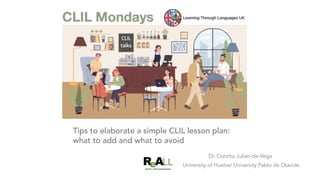
11.-CLIL-Mondays_-Lesson-plans_CJulian.pdf
- 1. Tips to elaborate a simple CLIL lesson plan: what to add and what to avoid Dr. Concha Julián-de-Vega University of Huelva/ University Pablo de Olavide
- 4. So stay calm and let’s start small!
- 5. First steps and tips … Sasin Tipchai
- 6. Six steps 1. Choose a possible subject 2. Choose a topic 3. Choose objectives and contents 4. Choose level of languages Sasin Tipchai 5. Make a plan
- 7. Some tips for the plan…
- 9. CLIL LESSON TEMPLATE with KEY ELEMENTS
- 10. CLIL LESSON TEMPLATE with KEY ELEMENTS
- 11. CLIL LESSON TEMPLATE with KEY ELEMENTS
- 12. CLIL LESSON TEMPLATE with KEY ELEMENTS
- 13. CLIL LESSON TEMPLATE with KEY ELEMENTS
- 14. An example for secondary level … Source: Hackney Learning Trust
- 17. An example for primary level … Authors: Inmaculada Peñarrocha & Bernadette Clinton. Hackney Learning Trust
- 20. And the 6th final step … 6. Enjoy and celebrate! Artturi Mäntysaari
- 22. References — Anderson, L.W., & Krathwohl (Eds.) (2001). ATaxonomy forLearning,Teaching, and Assessing:A Revision of Bloom'sTaxonomy of Educational Objectives. NewYork: Longman. — Bruner, J. S. (1975).The ontogenesis of speech acts. Journal of Child Language, 2:1-19. — Bonals, J. (1997). El trabajo en equipo del profesorado. Barcelona: Graó. — Coyle, D., Hood, Ph. & Marsh, D. (2010). CLIL: Content and Language Integrated Learning. Cambridge: Cambridge University Press — Cummins, J. (2000a). Language, Power and Pedagogy: Bilingual Children in the Crossfire. Clevendon: Mulitlingual matters.Traducción al español: Lenguaje , poder y pedagogía (2002). Madrid: Ministerio de Educación, Cultura y Deporte y Ediciones Morata — Estaire, S. y Zanón, J (1994). Planning Classwork: a task-based approach. Oxford: Heinemann. — García, O. (2009). Bilingual Education in the 21st. Century. A Global Perspective. Oxford:Wiley-Blackwell — Julián-de-Vega, C. y Fonseca-Mora, M.C. (2017). Language policy and teacher team coordination practices in secondary CLIL schools. European Journal of Language Policy 2:183-202. — Järvinen, H-M. (Ed.) (2009). Handbook: Language in Content Instruction. Finland: University of Turku. Recuperado el 4 de Junio de 2018, de: http://lici.utu.fi/materials/LICI_Handbook_EN.pdf — Instituto Cervantes (2002). Marco común europeo de referencia para las lenguas: aprendizaje, enseñanza, evaluación. Madrid: Instituto Cervantes,Anaya, Secretaría General Técnica del Ministerio de Educación, Cultura y Deporte.
- 23. Dr. Concha Julian-de-Vega University of Huelva/University Pablo de Olavide cjulve@upo.es Twitter: @Conchjulian Ka Young Seo Time for questions…